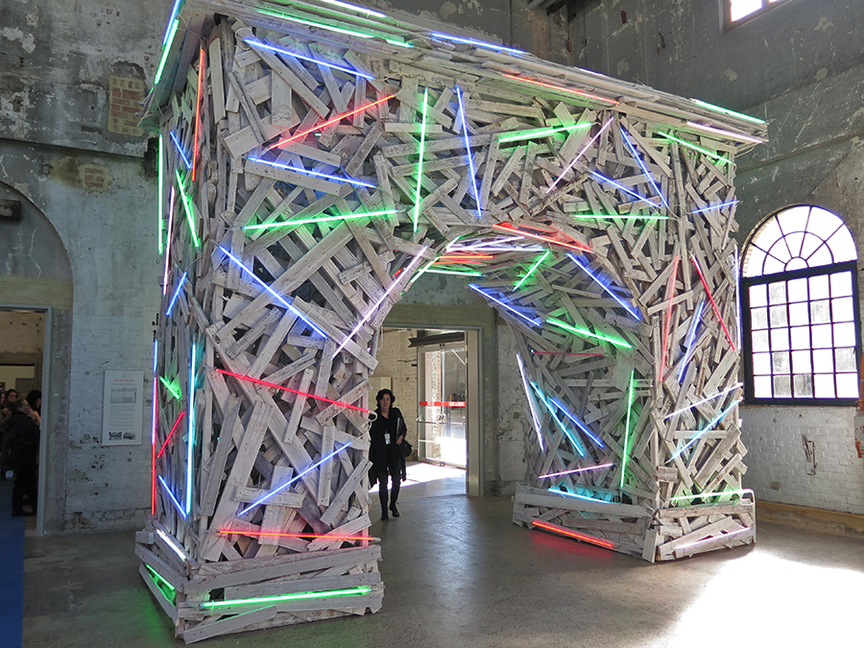
R
E
V N
E
X
T
With three art fairs last week in Sydney, the art-buying public were well catered for, with works selling at various price points, but mainly focused below AUD 100,000 (USD 71,000). Held every two years, Sydney Contemporary art fair, which is now in its second iteration, faced off against the inaugural The Other Art Fair (TOAF), which showcased young artists who are without gallery representation, and Spring 1883, a hotel-based fair in Melbourne that was started last year by the local Station Gallery, Neon Parc and Sarah Scout Presents.
The best seller at Sydney Contemporary seemed to have been mid-career Australian artist Ben Quilty. By the end of the day on the fair’s opening, Quilty’s Brisbane gallerist Jan Murphy had sold all of his thickly painted canvases, which flirt with abstraction while remaining firmly anchored in the figurative. “It is his first solo show in six years,” Murphy told ArtAsiaPacfic. With six pieces priced individually at AUD 60,000 (USD 43,000) and three at AUD 40,000 (USD 28,000) the work flew off the shelves.
Sydney gallery Sullivan+Strumpf—whose booth at the recent Art Basel Hong Hong showing Australian Sam Jinks’s sculpture of a coy, hyperrealistic nude female caused a selfie sensation—sold everything by their featured artist, Karen Black. “Very healthy sales,” said Joanne Sullivan, while also admitting to the notable absense of Jinks, always a crowd puller, at their Sydney Contemporary booth. Sullivan added: “There is just not enough work [by Jinks at the moment]. But we will take him to Shanghai’s upcoming Art021 in November.”
The crowd problems that plagued the inaugural 2013 edition of Sydney Contemporary—an overwhelming 14,000 people poured into the opening night party, clutching promotional free tickets—were also notably absent. Eariler, fair owner Tim Etchells told AAP that he predicted an attendance of 7,000 based on ticket sales, which proved to be a touch optimistic.
Etchells has since remained bullish about the success of Sydney Contemporary and says he is in for the long haul, even hinting that the event could well become an annual occurrence. He has solid art-fair credentials, having started ArtHK in Hong Kong in 2008 before selling a controlling interest of it to Art Basel in 2011. Earlier this year, Etchells launched Art Central in Hong Kong to coincide with Art Basel Hong Kong. He is also an investor in Sydney’s TOAF, thereby covering all financial bases, from the high end to the distinctly low end (as shown by the works included in TOAF), the latter of which involves artists whose work is not yet at a level to warrant gallery representation.
According to Etchells, and his Australian right-hand man Barry Keldoulis, international galleries see Carriageworks, the vast venue of Sydney Contemporary, as perhaps the best in the world for an art fair. “There is something about the marriage of [Carriageworks’s] Victorian industrial architecture and the intervention of contemporary art that seems to work,” Keldoulis said. It was a view confirmed by several galleries that AAP spoke to, which included Pearl Lam Galleries Shanghai—who was showing in Sydney for the first time and descibed the venue as fabulous, even though their sales where sluggish.
Sydney Contemporary markets itself as Australasia’s international art fair, claiming that one third of its exhibiting galleries this year was international. While statistically true, a number of that third were from New Zealand—a country long considered Australia’s annex. But global big-hitters from Hong Kong, such as Edouard Malingue, de Sarthe and 10 Chancery Lane, who exhibited in 2013, were a no show, and it was left to Pearl Lam to fly the international gallery flag, which she did with considerable aplomb. She showed work by Chinese abstract artists Zhu Jinshi and Su Xiaobai, as well as Australian-Chinese artist John Young and two works by Quilty—one of which sold on the first day. The gallery saw the fair more as a marketing opportunity and as a way of showing the Australian audience the diversity of Chinese art.
Gary Langsford, of New Zealand gallery Gow Langsford, echoed Pearl Lam: “It is all about relationship building. As a New Zealand gallery we must be here.” His booth was showing two large works by Dale Frank and two small, but sensational, sculptures by Tony Cragg priced at EUR 90,000 (USD 102,000) and EUR 125,000 (USD 142,000).
Many galleries were selling young and emerging Australia artists at more modest prices. Melbourne’s Dianne Tanzer unloaded several works by Natasha Bieniek—whose miniature landscapes won this year’s AUD 50,000 (USD 35,000) Wynne Prize at the Art Gallery of New South Wales—for AUD 9,000 (USD 6,400); Michael Reid of Sydney was doing good business selling Christian Thompson’s surreal, self-portrait photographs, while Melbourne’s Alcaston Gallery did “fantastic” business with Samoan photographer Greg Semu. Semu’s signature blend of history and eroticism sold briskly, with prices for the works ranging between AUD 5,800 (USD 4,100) to AUD 18,000 (USD 12,800).
Overall sales figures were not available for the three fairs at the time of writing, but Etchells was predicting AUD 10 million (USD 7 million) for Sydney Contemporary, while Geoff Newton of Neon Parc said sales from the Establishment Hotel’s various designer suites for Spring 1883 had been brisk. Newton had sold two Dale Franks at AUD 36,000 (USD 26,000) and remained very optimistic throughout the fair. Spring 1883, an invitation only fair, continues to show only work of a very high standard.
Of the three art fairs in town, TOAF was by far the weakest and demonstrated exactly why gallery representation is needed in the art ecology landscape. So much of the work on show in the pop-up Ambush Gallery space—located on the third story of a new mall—were of mediocre quality, which is something a good gallerist would have firmly pointed out.
Sydney Contemporary Art Fair and The Other Art Fair were on view on September 10–13; and Spring 1883 was showing on September 9–12.



